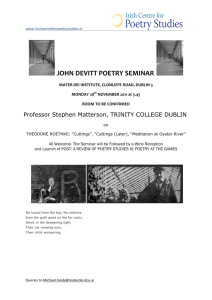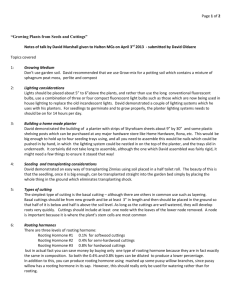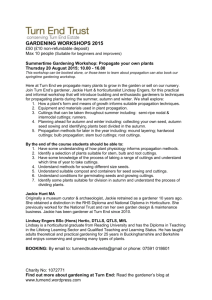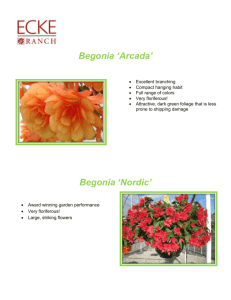PACIFIC SOUTHWEST Forest Range
advertisement
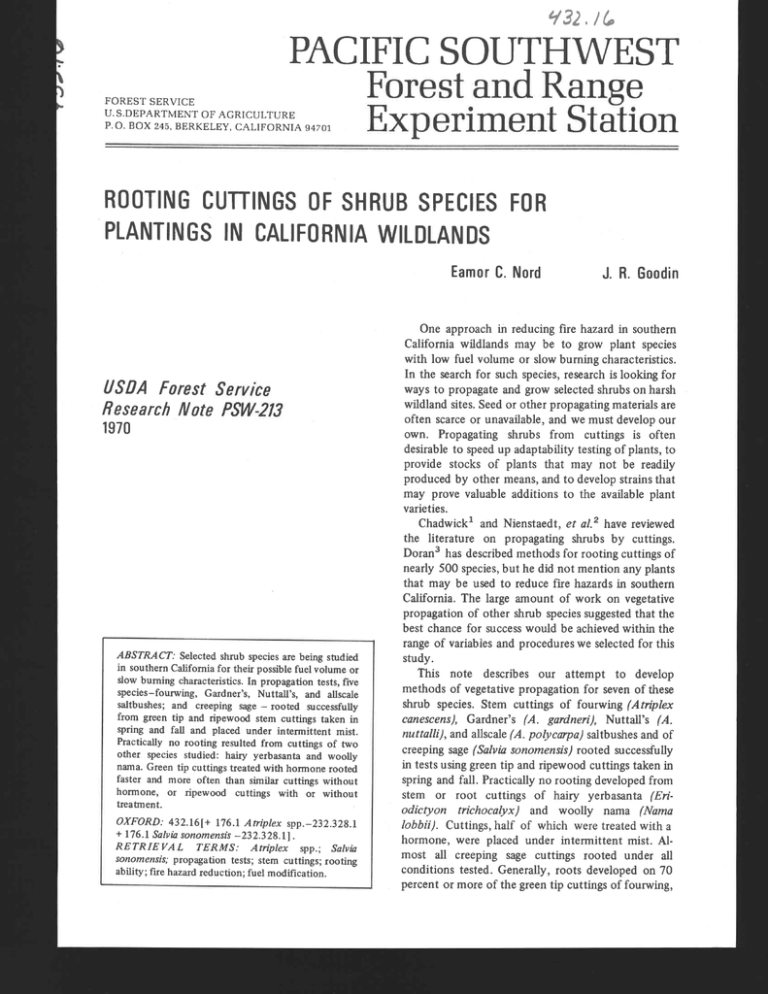
PACIFIC SOUTHWEST Forest and Range Experiment Station - FOREST SERVICE U. S.DEPARTMENT O F AGRICULTURE P.O. BOX 245, BERKELEY, CALIFORNIA 94701 ROOTING CUlTlNGS OF SHRUB SPECIES FOR PLANTINGS IN CALIFORNIA WILDLANDS Eamor C. Nord USDA Forest Service Research Note PSW-213 1970 ABSTRACT: Selected shrub species are being studied in southern California for their possible fuel volume or slow burning characteristics. In propagation tests, f i e species-fourwing, Gardner's, Nuttall's, and allscale saltbushes; and creeping sage - rooted successfully from green tip and ripewood stem cuttings taken in spring and fall and placed under intermittent mist. Practically no rooting resulted from cuttings of two other species studied: hairy yerbasanta and woolly nama. Green tip cuttings treated with hormone rooted faster and more often than similar cuttings without hormone, or ripewood cuttings with or without treatment. OXFORD: 432.16[+ 176.1 Atriplex spp.-232.328.1 + 176.1 Salvia sonomensis -232.328.11. RETRIEVAL TERMS: Atriplex spp.; Salvh sonomensis; propagation tests; stem cuttings; rooting ability; fire hazard reduction; fuel modification. J. R. Goodin One approach in reducing fire hazard in southern California wildlands may be to grow plant species with low fuel volume or slow burning characteristics. In the search for such species, research is looking for ways to propagate and grow selected shrubs on harsh wildland sites. Seed or other propagating materials are often scarce or unavailable, and we must develop our own. Propagating shrubs from cuttings is often desirable to speed up adaptability testing of plants, to provide stocks of plants that may not be readily produced by other means, and to develop strains that may prove valuable additions to the available plant varieties. chadwickl and Nienstaedt, et ~ 1 have . ~reviewed the literature on propagating shrubs by cuttings. or an^ has described methods for rooting cuttings of nearly 500 species, but he did not mention any plants that may be used to reduce fire hazards in southern California. The large amount of work on vegetative propagation of other shrub species suggested that the best chance for success would be achieved within the range of variables and procedures we selected for this study. This note describes our attempt to develop methods of vegetative propagation for seven of these shrub species. Stem cuttings of fourwing (Atriplex canescens), Gardner's (A. gardneri), Nuttall's (A. nuttalli), and allscale (A. polycmpa) saltbushes and of creeping sage (Salvia sonomensis) rooted successfully in tests using green tip and ripewood cuttings taken in spring and fall. Practically no rooting developed from stem or root cuttings of hairy yerbasanta (Eriodictyon trichocalyx) and woolly nama (Nama lobbii). Cuttings, half of which were treated with a hormone, were placed under intermittent mist. Almost a l l creeping sage cuttings rooted under all conditions tested. Generally, roots developed on 70 percent or more of the green tip cuttings of fourwing, Gardner's, and allscale saltbushes. Green tip cuttings treated with hormone rooted quicker and more often than similar cuttings without hormone, or than ripewood cuttings with or without hormone. METHODS AND MATERIALS The two types of cuttings we used-green tip cuttings from the terminal portion of current-year stem leaders, and ripewood cuttings from older stems which were generally woody throughout-were obtained in one spring season (1967) and two fall seasons (1966 and 1967). Forty cuttings of each kind were taken of each species at each season. Leaves were stripped from the basal one-half of 6- to 10-cm stems, and their basal end cut. Half of the cuttings were dipped in a hormone mixture of 0.8 percent indole-3-butyric acid (IBA) and talc before placing in the propagating flats. The other half Served as controls. Cuttings were labeled and placed vertically, with the basal end down about 5 cm deep into coarse No. 1 grade vermiculite in propagating flats. Twenty cuttings were used for each test of relative age of stems, hormone, season of collection, and for a control. Root and stem sections of woolly nama and ha j yerbasanta were used in the 1967 fall tests. For each of these two species, small (3 to 6 mm) and large (7 to 12 mm) diameter root sections treated with IBA hormone or untreated, were placed horizontally in vermiculite or a mixture of 75 percent sand and 25 percent sponge rock. Propagating flats were put on electrically heated bottom units to maintain 22OC., and watered by intermittent mist regulated to spray 10 seconds at 5-minute intervals. A fungicide was applied to the surface of the vermiculite every other week to minimize root-rot diseases. A few cuttings from all flats were examined weekly for callus and root development. Those with roots 1 cm or longer were counted as rooted and were removed from the flats. Unrooted cuttings were returned to the flats. After 60 days, all remaining cuttings were examined for live roots. Results, based upon total rooting during the 60-day period, were evaluated by Chi square tests. RESULTS AND DISCUSSION A high percentage of fourwing, Gardner's and allscale saltbushes, and of creeping sage cuttings treated with hormone rooted. Results varied considerably-depending upon season, relative age of cutting, and hormone, but exceeded 85 percent for the best treatment which for these species included green tip cuttings taken in fall and treated with hormone. Creeping sage rooting was 75 to 100 percent. Nuttall's saltbush rooting did not exceed 40 percent and was considerably lower than that for the other three saltbushes tested. Hairy yerbasanta and woolly nama stem cuttings rooted only occasionally. In 16 trials of the two species, the greatest rooting was 30 percent, all from stem cuttings. None of these rooted cuttings survived when transplanted into pots. Root cuttings failed to regenerate new plants, although some fresh shoots Table 1.-Effects of season and hormone treatments on the rooting of green tip and ripewood stem cuttings o f creeping sage and saltbushes1 Ripewood Green tips Honnone 1 Control 1 Hormone 1 Control No. cuttings rooted Season - FOURWING SALTBUSH 01 TRIPLEX CANESCENS) Fall 1966 Fall 1967 Average 90 a 1 88 x 65 ab 75 a 63xy 65 ab 45 b 85 a 65xy 35 b 60 ab 45 b 47 y CARDNER'S SALTBUSH (ATRIPLEX GARDNERI) Fall 1966 Fall 1967 95 a 60 ab 65 a 55 ab Average 95 a 60ab 85 a 50 ab 70xy 53 xy NUTTALL'S SALTBUSH (ATRIPLEX NUTTALLII) Fall 1966 Fall 1967 Average 20 ab 28 x 30 ab 1Oyz 23 xy 5z ALLSCALE SALTBUSH ( ATRIPLEX POL YCARPA) Fall 1966 Fall 1967 20 b 20 b Average 58 x 28 Y 17 yz 7z CREEPlNG SAGE (SAL VIA SONOMENSIS) Spring 1967 Fall 1966 Average 100 a 95 a 97 x 100 a 90 a 95 x 100 a (3) 100 x 95 a 75 a 85 x 'Hairy yerbasanta (Eriodictyon trichoca1yx)and woolly nama (Nama lobbii) practically all failed to root. 'values followed by the same letter do not differ significantly at the 5 percent probability level within each species according to Chi square tests. 3 ~ o tested. t became green and grew slightly. Rooted stem cuttings of other species generally continued to grow when transplanted into pots. Indole-3-butyric acid significantly increased the number of saltbush cuttings that rooted (table I). This hormone was more effective on green tip than on ripewood cuttings. Green tip cuttings treated with hormone gave 31 or greater percent rooting on the average for these species than those untreated. The differences were statistically significant. But hormone significantly increased rooting in only a few ripewood cuttings. Creeping sage cuttings, whether treated or untreated, yielded consistently high percentages of rooting. Rooting apparently was not affected by the season when cuttings were taken from saltbushes and creeping sage. But the relative age of cutting used affected the number of cuttings rooted from allscale and-to a lesser extent- by fourwing saltbush, especially hormone-treated cuttings. Green tip cuttings in spring and fall from allscale saltbush and from fourwing saltbush in fall had significantly more cuttings that rooted than ripewood cuttings made in these periods (table I). Relative age of cuttings did not affect rooting in the other two saltbushes or in creeping sage. Roots were generally about 2 cm longer and more abundant from cuttings treated with hormone than from untreated cuttings for all species except creeping sage and fourwing saltbush. This was true for both green tip and ripewood cuttings. Root masses developed mostly on the cuttings above the callus. Initial rooting of all species required 8 to 15 days, except hairy yerbasanta and woolly nama took considerably longer: Fall cuttings spring cuttings (dars) Species: Fourwing saltbush Gardner's saltbush Nuttall's saltbush Allscale saltbush Creeping sage Hairy yerbasanta Woolly nama 10 8 8 11 10 29 12 11 15 8 14 -- -- 40 Spring cuttings generally rooted in 2 to 7 days less time than fall cuttings from creeping sage and from all the saltbushes except allscale saltbush which rooted about 3 days quicker from fall cuttings. Initial rooting of stem cuttings under the different treatments took less than 2 weeks for all species, except hairy yerbasanta and woolly nama. Cuttings of those two species were in the propagating chamber 4 to 6 weeks before any rooting developed. Also, rooting was adversely affected by organisms, which made most of the stems turn brown and wither. Pathogens did not seem to affect cuttings from the other shrub species. But why cuttings from some species rooted better than others is not known. We expected that shrubs which stem layer profusely such as creeping sage or Nuttall's saltbush4 would root easily from stem cuttings. This was the case for cuttings from creeping sage, but those from Nuttall's saltbush rooted less than creeping sage or any of the other saltbushes which rarely stem layer. Conditions other than those considered in this study may be required for Nuttall's saltbush, hairy yerbasanta, and woolly nama to root more readily from stem cuttings. NOTES hadwi wick, L. C. The fundamentals o f propagating deciduous shrubs b y hardwood cuttings. Proc. Third Plant Prop. Soc. Annu. Meeting 1953: 120-133.1954. *~ienstaedt,Hans; Cech, F. C.; Mergen, F.; Wang, Chi-Wu; and Zak, B . Vegetative propagation in forest genetics research and practice. J. Forestry 56(11): 826-839.1958. 3 ~ o r a n ,W. L. Bopagation o f woody plants by cuttings. Univ. Mass. A@. Exp. Sta. Bull. 491,99p. 1957. 4 ~ o r d ,E. C.; Christensen, D. R.; and Plurnrner, A. P. Atriplex species (or taxa) that spread b y root sprouts, stem layers, and by seed. Ecology 50(2): 324-326.B69. The Authors EAMOR C. NORD is a plant ecologist assigned to research on low-volume vegetation, with headquarters at the Station's Forest Fire Laboratory, Riverside, California. He is a native of Idaho Falls, Idaho. He attended Long Beach Junior College, University of Idaho (B.S., forestry, 1940), and Texas A & M University (M.S., range science, 1953; and Ph.D., range science, 1956). J. R. GOODIN at the time of this study was assistant professor and assistant agronomist at the University of California, Riverside. He is now an Associate Professor of biology at Texas Tech University, Lubbock. Native of Claude, Tex., he attended Texas Technological College (B.S., horticulture, 1955), Michigan State University (M.S., horticulture, 1958), and the University of California, Los Angeles (Ph.D., plant science, 1963). The Forest Semce of the U.S. Department of Agriculture . . . Conducts forest and range research at more than 75 locations from Puerto Rim to Alaska and Hawaii. . . . Participates with all State forestry agencies in cooperative programs to protect and imprwe the Nation's 395 million acres of State, local, and private forest lands. . . . Manages and protects the 187-million-acre National Forest System for sustained yield of its many products and services. The Pacific Southwest Forest and Range Experiment Station represents the research branch of the Forest Service in California and Hawaii.


